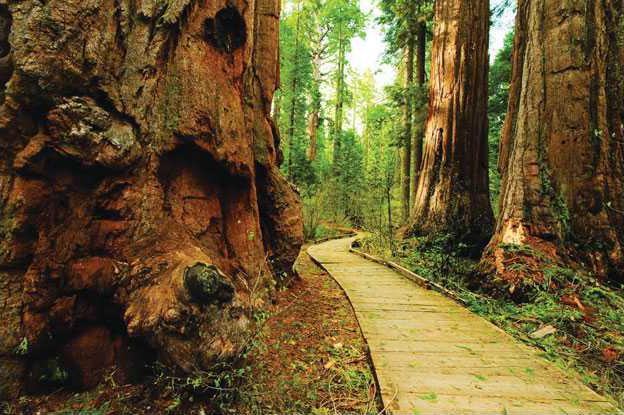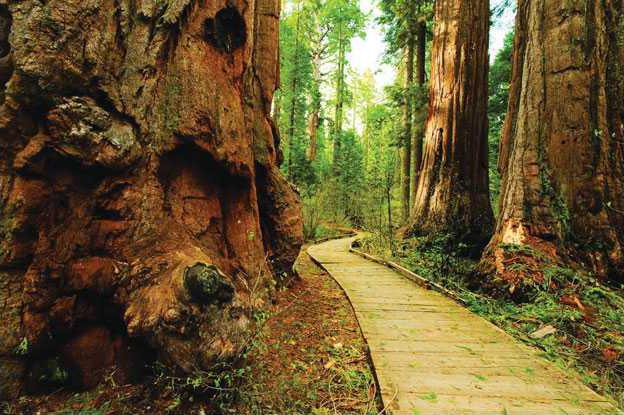ARNOLD — Three miles north of Arnold off Highway 4, the colossal trees of Calaveras Big Trees State Park stand in quiet testimony to prehistoric times.
These massive relics, which can reach a height of 325 feet and a diameter of 33 feet, are descended from trees that were standing when dinosaurs roamed Earth, and birds, mammals and flowering plants began to appear. Some of today’s trees are thought to be as old as 2,000 years.
Located at the mid-elevation level of the western Sierra, Calaveras Big Trees State Park is a prime example of a mixed conifer forest in the yellow pine belt. Giant sequoias dominate ponderosa pines, sugar pines, incense cedars and white fir. The Pacific dogwood displays white blossoms in the spring. Wildflowers along the Lava Bluffs Trail include leopard lily, Hartweg’s iris, crimson columbine, monkey-flowers, harvest brodiaea, wild hyacinth and lupine.
The North Grove
In 1928 Californians voted to establish a state park system through a bond act. Private donors supporting the acquisition of the North Grove included John D. Rockefeller, Jr., and Mrs. William H. Crocker. The rest of the funding came from the Calaveras Grove Association and the Save the Redwoods League. At last, in 1931, the North Grove came under the protection of the State of California. Now all that was left was to find a way to acquire the South Grove.
The South Grove
Unfortunately, the world was then in the throes of the Great Depression. Newton B. Drury, acting as Land Acquisition Officer for the then California Division of Beaches and Parks, decided against the acquisition, citing “the condition of the state park bond fund and the difficulty in raising private gifts.”
It took another 23 years before the South Grove was acquired. These years were rocked by two wars, with on-again/off-again negotiations with the Pickering Lumber Company, revival of the defunct Calaveras Grove Association, and a massive grassroots fundraising campaign to preserve the quality of this untouched forest. Finally, on April 16, 1954, the Calaveras South Grove became part of Calaveras Big Trees State Park.
RECREATION
Camping — The North Grove Campground has more than 70 campsites; the Oak Hollow Campground has more than 50 campsites. Both can accommodate tents and RVs up to 30 feet. All campsites have fire rings and picnic tables; piped water, flush toilets and coin showers are nearby. Visit www.parks.ca.gov or call (800) 444.7275 for reservations.
Trails — The North Grove has a level, 1.5-mile self-guided trail. The .13-mile Three Senses Trail allows visitors to experience the feel, smell and sounds of this magnificent forest. The five-mile South Grove Trail travels along Big Trees Creek and passes the park’s two largest trees —the Agassiz Tree and the Palace Hotel Tree. The fairly strenuous four mile River Canyon Trail runs between the North Grove and the Stanislaus River. Along the Lava Bluffs Trail, hikers can enjoy the scenic North Fork of the Stanislaus River.
Picnicking/Swimming — Designated picnic areas are located alongside the Stanislaus River, in the North Grove, Oak Leaf Spring and Beaver Creek areas.
Fishing — The Stanislaus River and Beaver Creek offer good fishing, particularly for rainbow trout. A valid California fishing license is required.
Wildlife — Opportunities for wildlife observation are abundant in the park. Bird species include pileated woodpeckers, northern flickers, Steller’s jays and darkeyed juncos. Raccoons, foxes, porcupines, chipmunks, chickarees and flying squirrels are among the native animals. Black bears, bobcats and coyotes are sometimes seen.





